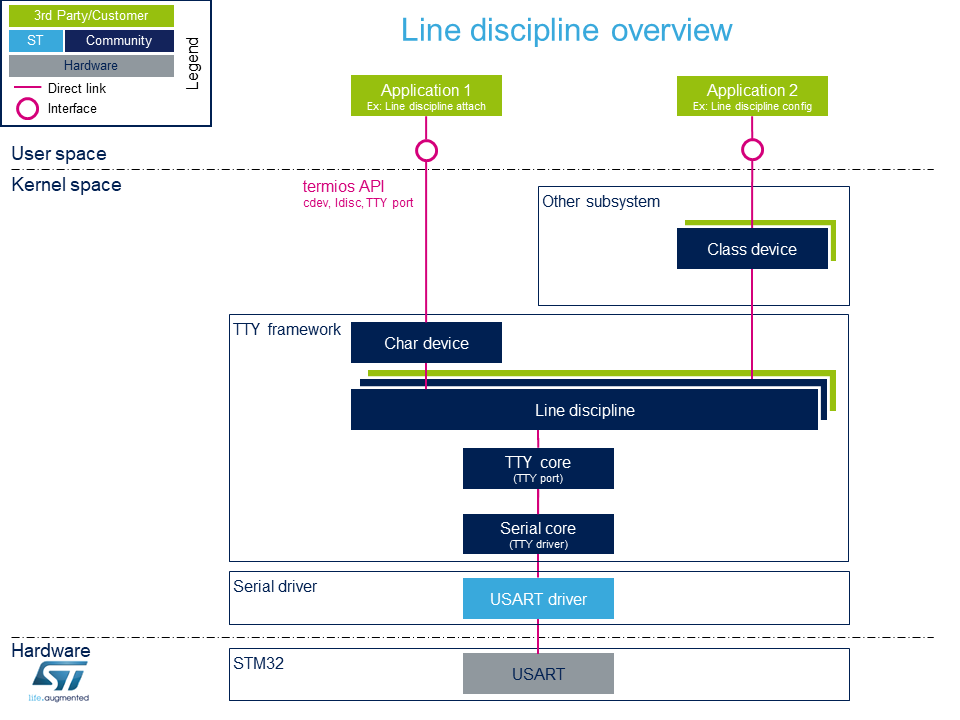“Serial TTY line discipline”的版本间的差异
来自百问网嵌入式Linux wiki
| (未显示2个用户的5个中间版本) | |||
| 第1行: | 第1行: | ||
| − | [[ | + | 本文提供有关 Linux® TTY 框架的信息。 它说明了如何使用线路规则激活“ UART”接口,以及如何从用户和内核空间访问它。<br /> |
| − | + | ||
| − | + | ==Framework purpose== | |
| + | UART是几种设备类型(例如蓝牙,NFC,FM收音机和GPS设备)的通用接口。 <br/> | ||
| + | 从内核版本4.12开始,TTY框架中引入了串行设备总线(也称为Serdev),以改善提供给连接到串行端口的设备的接口。 请参考 [[Serial TTY overview]]文章,以详细了解TTY框架的用途。尽管如此,仍然有可能(即使不推荐)使用行规“驱动程序”。 | ||
| + | 本文重点介绍提供给连接到串行端口的设备的线路规范接口。 | ||
| + | |||
| + | ==System overview== | ||
| + | [[File:Serial TTY Line Discipline overview.png|center|link=]] | ||
| + | <br/> | ||
| + | |||
| + | ===Components description=== | ||
| + | ''从客户端应用程序到硬件'' | ||
| + | * 应用程序:客户应用程序,用于从串行端口上连接的外围设备读取/写入数据。 | ||
| + | |||
| + | * [[TTY tools]]: Linux社区提供的工具,例 '''stty''', '''ldattach''', '''inputattach''', '''tty''', '''ttys''', '''agetty''', '''mingetty''', '''kermit''' and '''minicom'''. | ||
| + | |||
| + | * Termios: API<ref name="termios API">[http://man7.org/linux/man-pages/man3/termios.3.html termios API], Linux Programmer's Manual termios API Documentation (user land API with serial devices)</ref> 提供使用串行驱动程序开发应用程序的接口。 | ||
| + | *客户端子系统:'''TTY'''内核的内核子系统客户端(示例:蓝牙设备) | ||
| + | |||
| + | * TTY框架:高层TTY结构管理,包括 {{CodeSource | Linux kernel | drivers/tty/tty_io.c | '''tty character device driver'''}}, {{CodeSource | Linux kernel | drivers/tty | '''TTY core functions'''}}, [[Serial TTY line discipline| '''line discipline''']]. | ||
| + | |||
| + | * 串行框架:低级串行驱动程序管理,包括{{CodeSource | Linux kernel | drivers/tty/serial/serial_core.c | '''serial core''' functions}}. | ||
| + | |||
| + | * USART驱动程序:{{CodeSource | Linux kernel | drivers/tty/serial/stm32-usart.c | stm32-usart}} '“低级串行驱动程序'”,用于所有stm32系列设备。 | ||
| + | * [[USART internal peripheral| STM32 USART]]: ''' STM32前端IP''' 通过串行端口连接到外部设备 | ||
| + | |||
| + | ===APIs description=== | ||
| + | |||
| + | TTY仅向用户空间提供'''字符设备接口'''(命名为/ dev / ttyX)。 | ||
| + | 用户空间TTY客户端应用程序的主要API由便携式POSIX终端接口termios提供,该终端依靠/ dev / ttyX接口进行TTY链接配置。<br/> | ||
| + | |||
| + | '''termios API'''<ref name="termios API"/> 是用户登陆API,其功能描述了提供的通用终端接口,用于控制异步通信端口。 <br/> | ||
| + | |||
| + | POSIX termios API抽象化了硬件的底层细节,并提供了一个简单而完整的编程接口,可用于高级项目。 它是'''字符设备API'''<ref> [http://bootlin.com/doc/accessing-hardware.pdf Character device API overview], “从用户空间访问硬件”培训,Bootlin的包装 文档</ ref> ioctl操作。<br/> | ||
| + | |||
| + | {{Info|A [[Serial TTY line discipline|'''line discipline''']]当需要在内核级别使用串行接口时,可以使用驱动程序。}} | ||
| + | 例如,可能需要内核驱动程序通过U(S)ART端口控制外部设备。 | ||
| + | |||
| + | * '''line discipline''' 将负责: | ||
| + | ** 创建这个新的内核API | ||
| + | ** 在串行内核和新内核API之间路由数据流<br/> | ||
| + | |||
| + | ==References== | ||
| + | <references /> | ||
| + | |||
| + | <noinclude> | ||
| + | [[Category:Serial TTY|6]] | ||
| + | </noinclude> | ||
2020年11月9日 (一) 10:57的最新版本
本文提供有关 Linux® TTY 框架的信息。 它说明了如何使用线路规则激活“ UART”接口,以及如何从用户和内核空间访问它。
目录
Framework purpose
UART是几种设备类型(例如蓝牙,NFC,FM收音机和GPS设备)的通用接口。
从内核版本4.12开始,TTY框架中引入了串行设备总线(也称为Serdev),以改善提供给连接到串行端口的设备的接口。 请参考 Serial TTY overview文章,以详细了解TTY框架的用途。尽管如此,仍然有可能(即使不推荐)使用行规“驱动程序”。
本文重点介绍提供给连接到串行端口的设备的线路规范接口。
System overview

Components description
从客户端应用程序到硬件
- 应用程序:客户应用程序,用于从串行端口上连接的外围设备读取/写入数据。
- TTY tools: Linux社区提供的工具,例 stty, ldattach, inputattach, tty, ttys, agetty, mingetty, kermit and minicom.
- Termios: API[1] 提供使用串行驱动程序开发应用程序的接口。
- 客户端子系统:TTY内核的内核子系统客户端(示例:蓝牙设备)
- TTY框架:高层TTY结构管理,包括 drivers/tty/tty_io.c | |}} tty character device driver , drivers/tty | |}} TTY core functions , line discipline.
- 串行框架:低级串行驱动程序管理,包括drivers/tty/serial/serial_core.c | |}} serial core functions .
- USART驱动程序:drivers/tty/serial/stm32-usart.c | |}} stm32-usart '“低级串行驱动程序'”,用于所有stm32系列设备。
- STM32 USART: STM32前端IP 通过串行端口连接到外部设备
APIs description
TTY仅向用户空间提供字符设备接口(命名为/ dev / ttyX)。
用户空间TTY客户端应用程序的主要API由便携式POSIX终端接口termios提供,该终端依靠/ dev / ttyX接口进行TTY链接配置。
termios API[1] 是用户登陆API,其功能描述了提供的通用终端接口,用于控制异步通信端口。
POSIX termios API抽象化了硬件的底层细节,并提供了一个简单而完整的编程接口,可用于高级项目。 它是字符设备API<ref> Character device API overview, “从用户空间访问硬件”培训,Bootlin的包装 文档</ ref> ioctl操作。
| A line discipline当需要在内核级别使用串行接口时,可以使用驱动程序。 |
例如,可能需要内核驱动程序通过U(S)ART端口控制外部设备。
-
line discipline 将负责:
- 创建这个新的内核API
- 在串行内核和新内核API之间路由数据流
References
- ↑ 1.01.1 termios API, Linux Programmer's Manual termios API Documentation (user land API with serial devices)